It's actually both here. It is indeed a point on the solar cell's I/V characteristic, but it's also the voltage drop across the load.
The reason for this is that the circuit schematic you have here is a model for how a solar cell ought to behave, with a terminal to which a load is attached. When the load is unspecified, the exact output voltage and current are underconstrained and can live anywhere on the cell's I/V curve.
This is similar to how an equivalent circuit for a battery may have a voltage source and series resistor, and can be solved with the load attached to find the battery output voltage which equals voltage across the load.
Attach the load (or an equivalent circuit for the load) on your schematic and solve the two together. This can be done numerically by solving circuit equations, or graphically if you have I/V characteristic curves for the solar cell and load by searching for the intersection.
Assuming there is a stable solution (which should occur barring anything weird like negative differential impedances) you will obtain a circuit solution describing how the load and solar cell interact, including the actual voltage drop across the load, and current supplied to the load.
